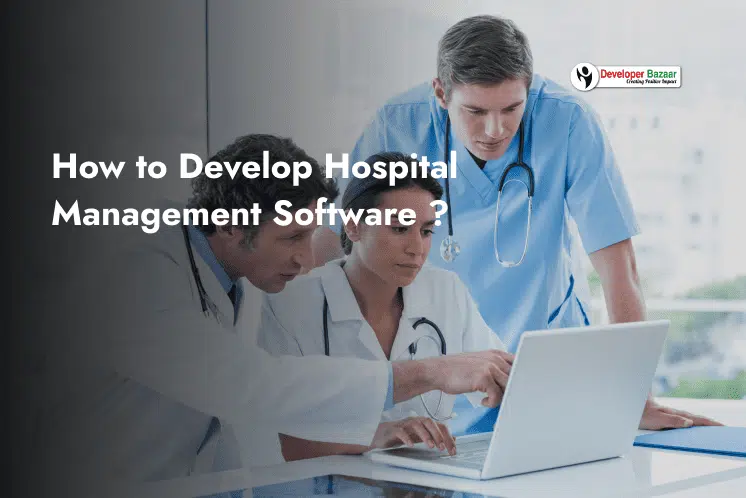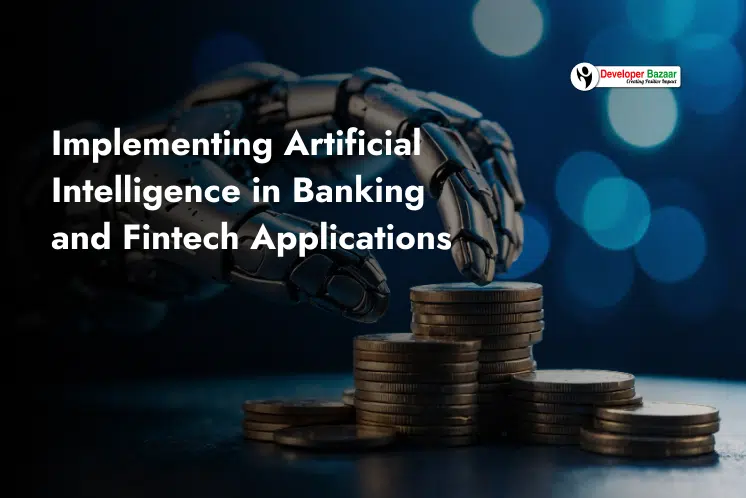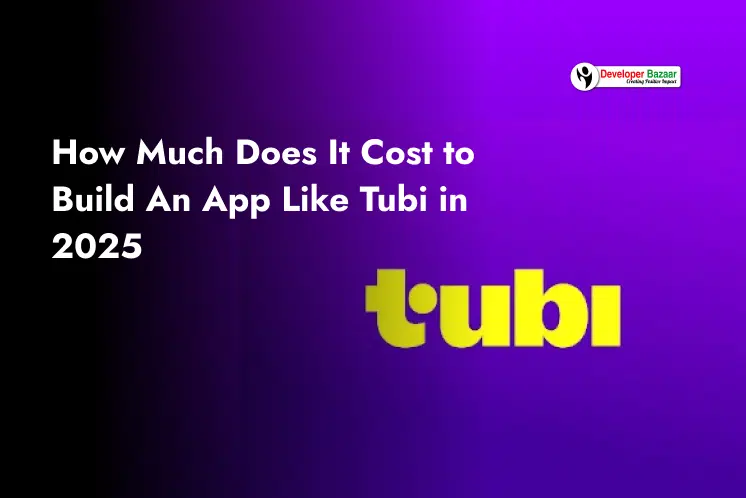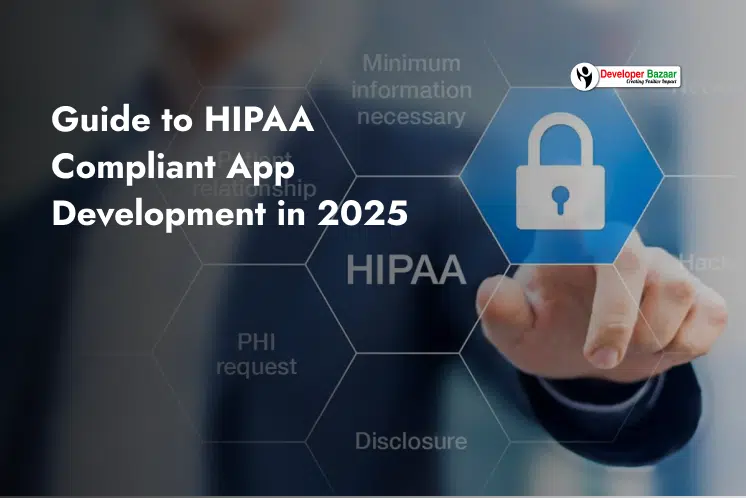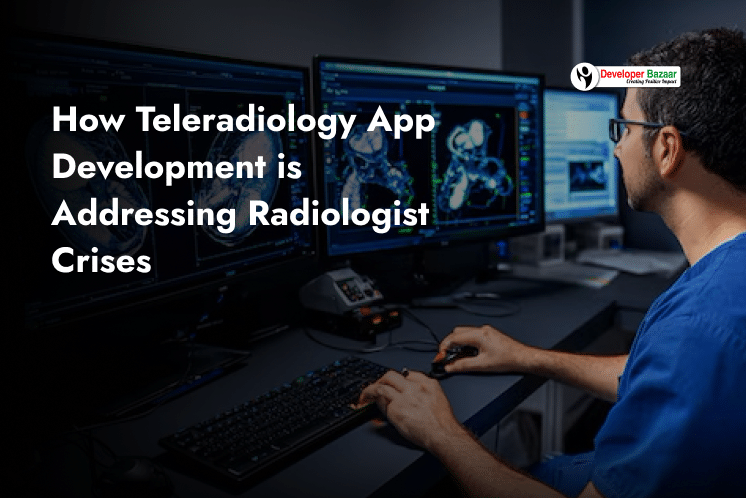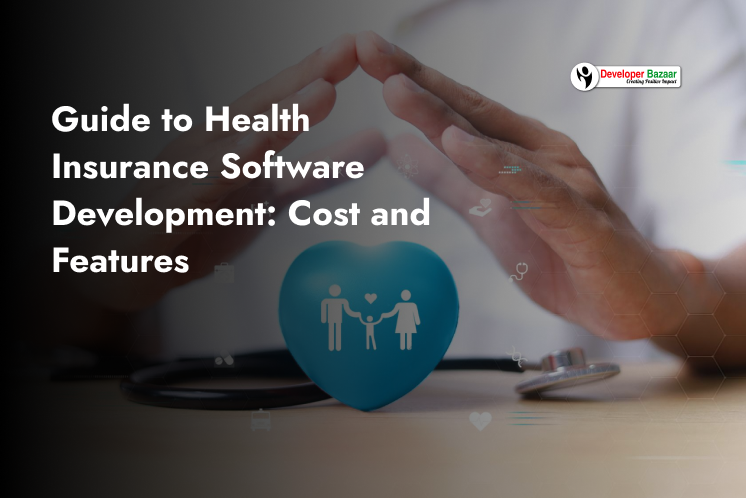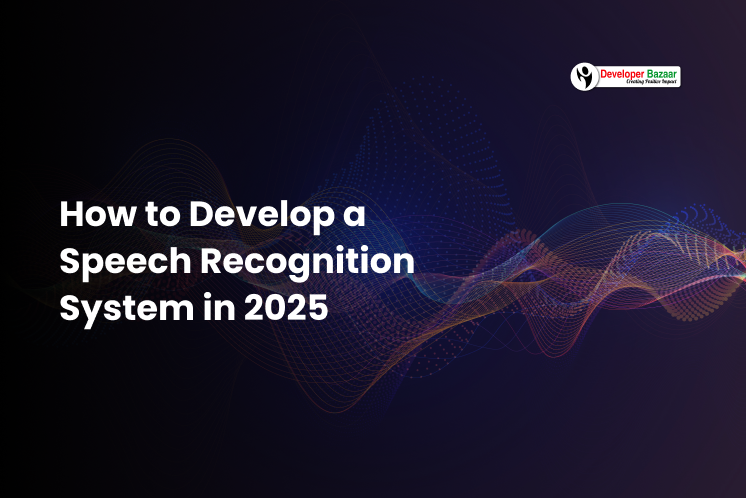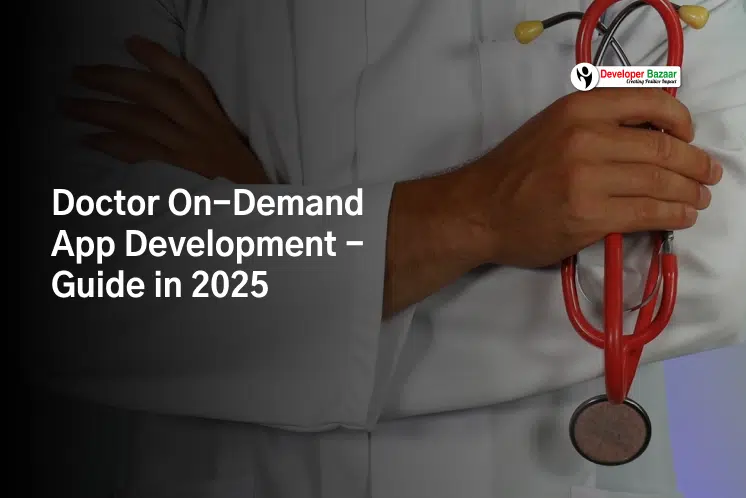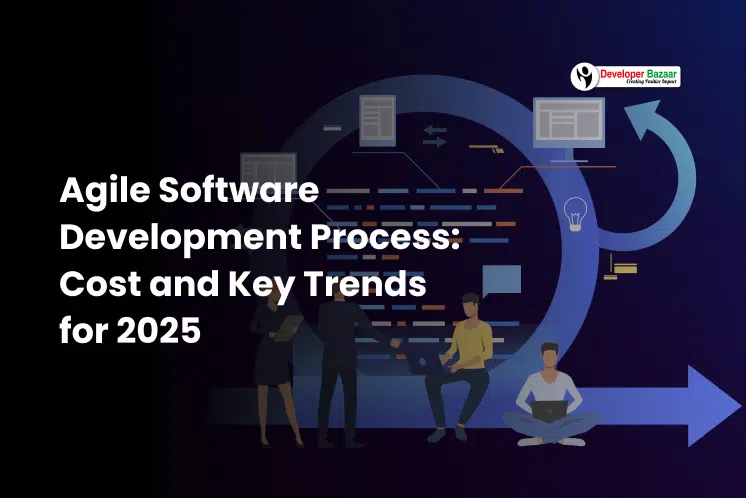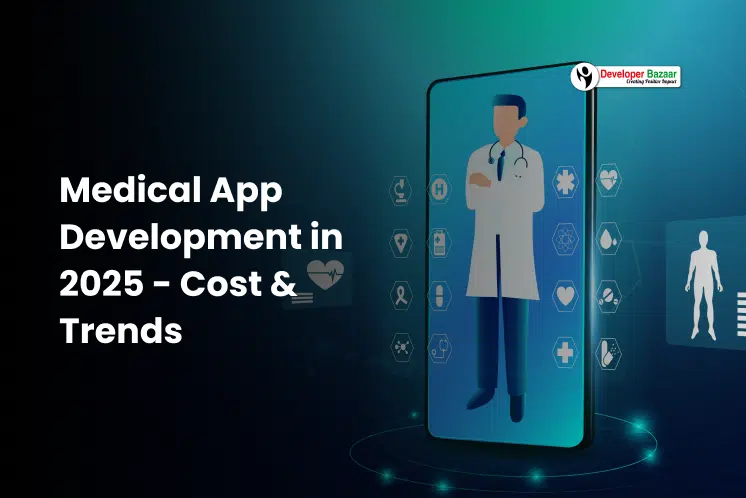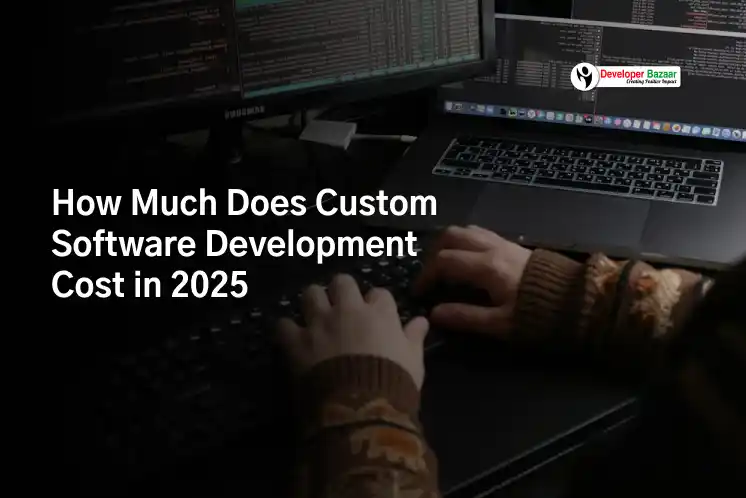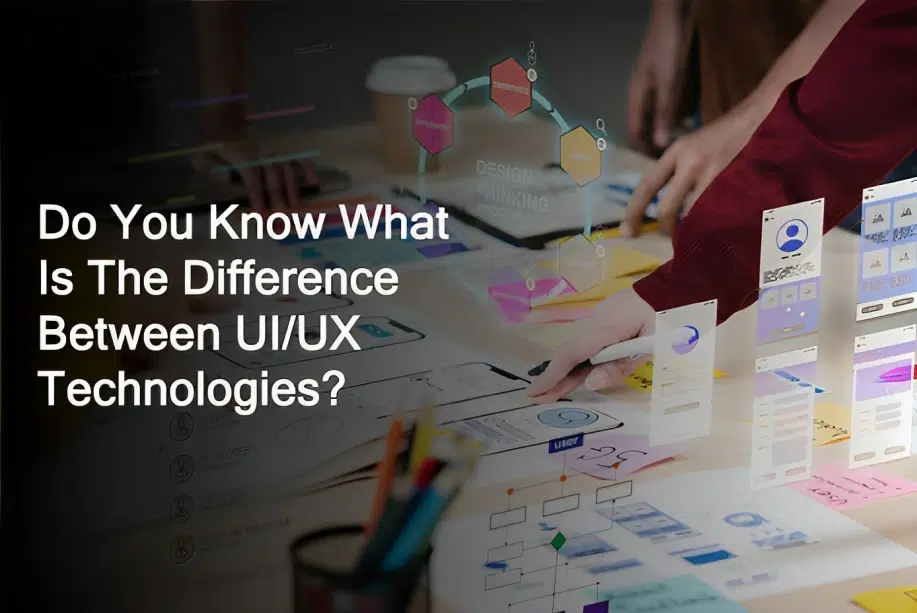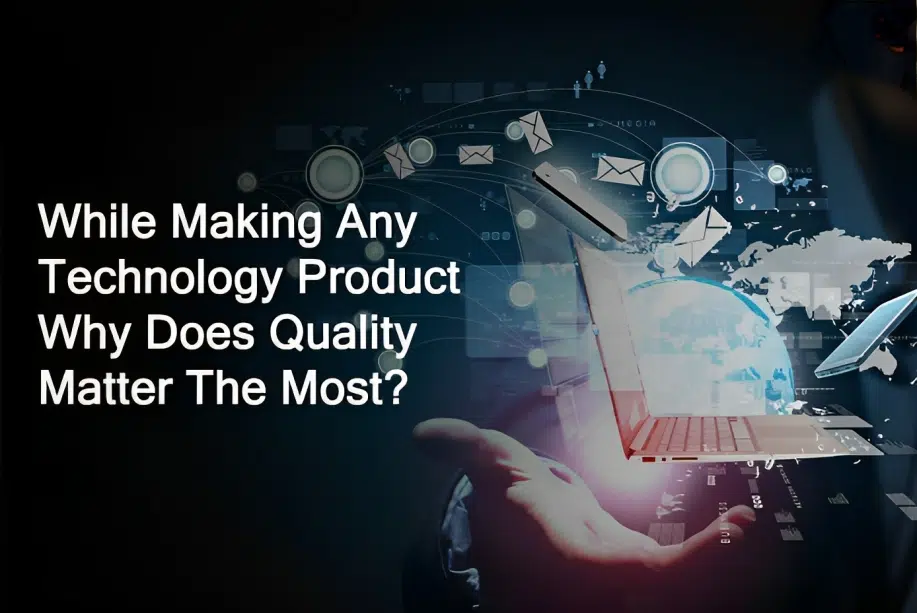Table of Contents
ToggleBlog Summary: This guide explains Remote Patient Monitoring Software in simple words. You’ll learn what it means, how it works, its growing market value, and the key benefits for patients and doctors. We also cover development tips, costs, and future trends to help anyone interested in making or using this type of software.
What is Remote Patient Monitoring?
Remote Patient Monitoring (RPM) is a smart way for doctors to keep track of a patient’s health without requiring them to visit the hospital or clinic often. With the help of technology, health data like heart rate, blood pressure, and oxygen levels can be collected using wearables or home devices. This data is then shared with doctors in real-time.
RPM is different from traditional patient monitoring that happens only inside hospitals. With RPM, the monitoring happens at the patient’s home. This makes it easy for people with long-term illnesses or elderly patients to stay safe and healthy without always needing to travel.
There are different types of Patient Monitoring Software systems:
- Cardiac Monitoring - Tracks heart activity for patients with pacemakers or heart conditions.
- Baseline Signs Monitoring - Measures basic health signs like sugar levels, temperature, and oxygen.
- Pregnancy Monitoring - Monitors the health of both mother and baby.
- Depression Monitoring - Watches sleep, mood, and movement to help detect signs of depression.
These systems work using Remote Patient Monitoring Software, making it easy to manage health from anywhere.
How Does Remote Patient Monitoring RPM Works?
Remote Patient Monitoring Software works in a 5 simple step process:
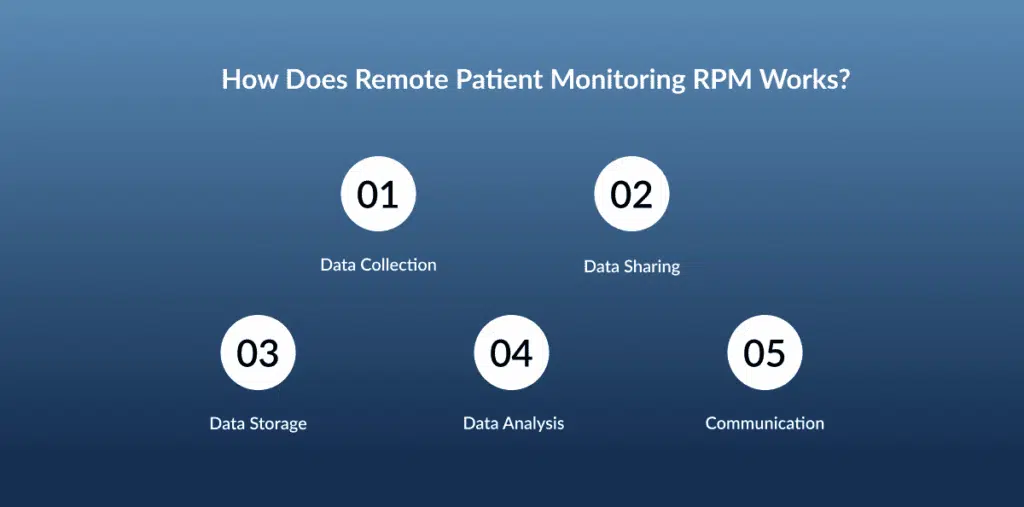
1. Data Collection
Devices like smartwatches, sensors, or trackers collect important health information. For example, a smartwatch may track your heartbeat or sleep.
2. Data Sharing
The collected data is sent to doctors through the internet, Wi-Fi, or Bluetooth. This happens in real-time.
3. Data Storage
The software stores this health data safely in cloud systems. This makes it easy to access later.
4. Data Analysis
Using smart AI tools, the system checks the data. If there’s a problem, it sends alerts to doctors or caregivers.
5. Communication
Doctors and patients can talk using the software. Some Patient Monitoring Software includes video or chat options. It helps doctors give advice or send help quickly.
This is how Remote Patient Monitoring Software Development connects patients and healthcare providers in a fast and smart way.
Global Market Overview: Remote Patient Monitoring
The Remote Patient Monitoring market is growing fast. Research and Market shows that In 2023, it was worth $1.6 billion. Experts believe it will grow to $3.4 billion by 2030. Why? Because more people care about their health today.
Plus, after COVID-19, many people want to track health from home. There are few more reasons mentioned below that is behind this huge growth:
- Half of the world’s people live far from hospitals.
- Many people want to eat better and live healthier lives.
- The wellness market is also growing and is expected to be $7.2 trillion by 2025.
Investors are also showing big interest in digital wellness tools and Remote Patient Monitoring Software. But there’s still space for new companies to create better solutions. This offers more opportunity for every healthcare app development company to enter in this competitive market.
Benefits of Using Remote Patient Monitoring Software
Remote Patient Monitoring Software is changing the way how healthcare works. It helps doctors give better care and helps patients stay healthier, without always needing to visit a clinic.
By this it becomes easier whether it’s checking on chronic conditions or helping clinics. RPM offers many real and useful benefits.

1. Easy Access to Health Data
With Remote Patient Monitoring Software, doctors can check patient data anytime, from anywhere. This means they can quickly respond to small health changes before they become big problems. Patients don’t need to visit the hospital just to get basic check-ups.
2. Healthier Living
RPM devices like smartwatches, fitness bands, and trackers make people more aware of their daily health. These tools help patients track things like blood pressure, sugar levels, and sleep. When people see their numbers every day, they can make better health choices.
3. Saves Money
Doctors can spot problems early, and patients avoid costly emergency visits. Also, regular remote check-ups cost less than in-person visits. This helps reduce the overall Patient Monitoring Software cost for both healthcare providers and patients.
4. Fewer Hospital Visits
Many patients return to the hospital for simple issues like dizziness or high blood pressure. But these can often be checked and handled through RPM. Doctors can watch patient vitals from afar and act only if something serious happens.
5. Lower Care Costs
Remote care means fewer in-person tests and appointments. That leads to fewer unnecessary treatments. Patients spend less, and hospitals save on resources, making care more affordable overall.
6. Fewer Missed Appointments
With video calls and online consultations, patients don’t have to travel or wait in long lines. This makes it easier to keep up with regular doctor visits, especially for people who live far away or have busy schedules.
7. Doctors Can Focus More
RPM tools handle regular tracking of basic health data. This means nurses and doctors don’t have to spend time checking routine things. They can use that time to care for patients who need urgent or complex treatment. It also reduces their workload and helps prevent burnout.
8. More Revenue for Clinics
Hospitals and clinics can earn more by using Remote Patient Monitoring Software Development. They can offer new services, save money on staff time, and even get rewards from health programs like Medicare and Medicaid. It’s a smart way to grow and improve care.
Patient Monitoring Software development Solution: Step-By-Step Guide
Developing Remote Patient Monitoring Software means creating a digital tool that helps doctors keep track of their patients’ health, even when they’re not in the hospital. This kind of software is very helpful for people with long-term illnesses or those who need regular check-ups at home.
Step 1: Understand Your Requirements
The first step is to talk with your software development company. You don’t need a full plan at this point, just a basic idea of what you want the app to do and which health problems it will focus on (like diabetes, heart disease, etc.).
Once you share your idea, the team will help you figure out what features your app should include, which technologies are best to use, and how to connect the app with systems like electronic health records (EHRs). This step is all about planning and getting on the same page with the development team.
Step 2: Ensure Data Privacy and Security
Patient health information is very private and must be protected carefully. In this step, the development team makes sure the app follows healthcare rules like HIPAA. They add encryption to keep the data safe, choose secure cloud storage options, and prepare the app to meet FDA and other healthcare regulations.
The team also plans how to test the app safely before it goes live. This step is very important because strong security protects both the patient’s information and your business.
Step 3: Design a Simple and Clear App
The app must be easy to use for both patients and doctors. In this step, the designers talk to real users to understand their needs. They create a prototype, which is like a rough draft of the app, and then gather feedback from you or users.
Based on this feedback, they make changes to improve the design. The main goal here is to build an app that anyone, whether young or old, can use without getting confused.
Step 4: Develop and Connect the App
Now it’s time to actually build the app. The development team works on creating different parts of the software. This includes a mobile app for patients, a dashboard for doctors, and backend systems to handle data and processes.
They also connect the app with medical devices like wearables or monitors. The app is developed in smaller parts, called “iterations,” and is tested after each part to make sure everything works smoothly.
Step 5: Test Everything
Before the app is launched, it must be tested carefully to find and fix any bugs or errors. In this step, the team checks if the app works well on different devices like phones and tablets.
They also make sure the app connects properly with smart medical devices, such as heart rate monitors.
Additionally, the app is tested for security, speed, and overall performance. This helps ensure that users will have a smooth experience and trust the software.
Step 6: Keep Improving After Launch
Once your app is live, the work doesn’t stop. The software development company keeps monitoring the app to make sure it performs well. They fix any problems that come up and also provide training materials to help patients and doctors learn how to use the app properly.
Over time, they may add more features to improve the app. This step helps the app stay useful and up to date in the long run.
What Cost It Will Take in Remote Patient Monitoring Software Development
The cost of patient monitoring software depends on how complex your app is and who builds it.
Here’s a general cost breakdown:
| Role | Rate per Hour |
|---|---|
| Business Analyst | $40–$63 |
| Project Manager | $45–$70 |
| Junior Developer | $25–$42 |
| Senior Developer | $55–$90 |
| UI/UX Designer | $35–$56 |
| QA (Tester) | $25–$63 |
Overall, to build the fully featured Remote patient monitoring platform, the total cost can be around $200,000 to $400,000.
Features to Include in a Remote Patient Monitoring Solution
If you want to build a good remote patient monitoring software, you need to include the right features. These features should help doctors care for patients from far away. Your app should also be easy to use and safe for patient data.
Below are must-have features explained that help you to get idea what features you need to add in your RPM Platform.
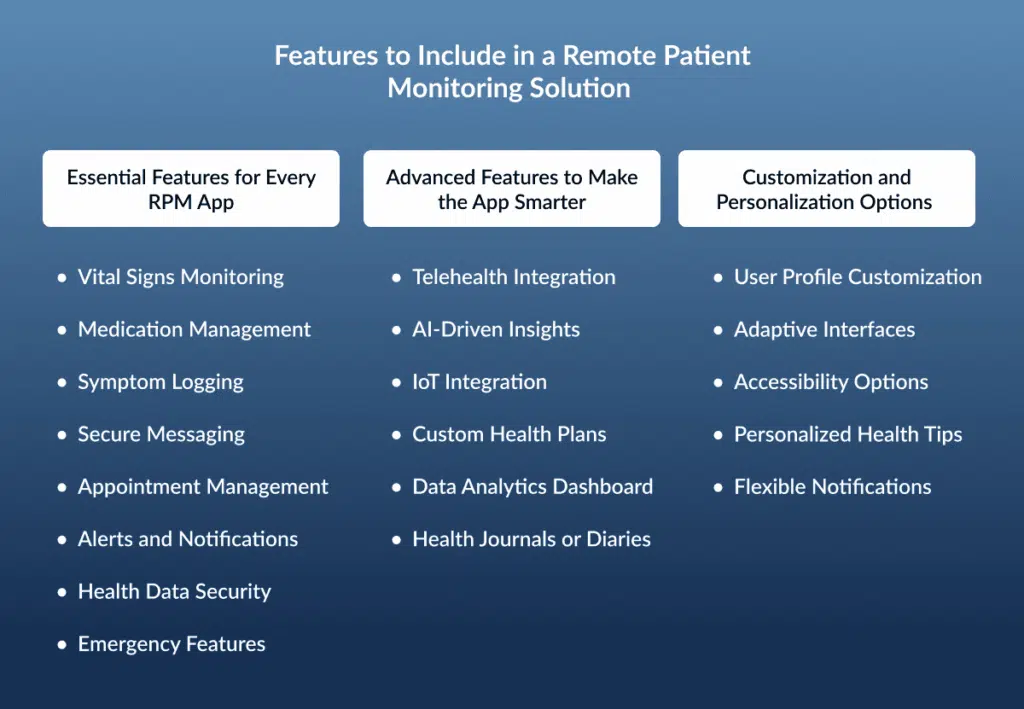
Essential Features for Every RPM App
These are the must-have features for basic patient monitoring software development:
- Vital Signs Monitoring: The app should track key health numbers like heart rate, blood pressure, sugar levels, and oxygen levels. This helps doctors understand how the patient is doing every day.
- Medication Management: Patients can set reminders to take their medicine. The app should also track if they are taking it on time.
- Symptom Logging: Patients should be able to easily write down how they feel or report any new symptoms. This helps doctors react quickly if something changes.
- Secure Messaging: Patients and doctors should be able to chat safely inside the app. It protects private health info.
- Appointment Management: Patients can book, change, or cancel doctor visits directly from the app.
- Alerts and Notifications: The app should send important messages like medication reminders or alerts about upcoming appointments.
- Health Data Security: The app must protect patient data. It should follow health laws like HIPAA and use data encryption.
- Emergency Features: Gives thThe app should have an emergency button or show important health info quickly during an urgent situation.
Advanced Features to Make the App Smarter
If your budget allows, you can add more advanced features to your remote patient monitoring software:
- Telehealth Integration: Add video calling so patients can talk to doctors directly from the app.
- AI-Driven Insights: Use smart technology to read patient data and alert doctors if there are health risks.
- IoT Integration: Connect the app with smart devices like fitness bands or heart monitors. This way, health data goes into the app automatically.
- Custom Health Plans: Doctors can create special care plans for each patient and track their progress.
- Data Analytics Dashboard: Show trends and charts to help doctors understand the patient’s health over time.
- Health Journals or Diaries: Let patients write daily notes about their mood, food, or sleep. This can help track habits and improve care.
Customization and Personalization Options
A good healthcare app development company will build features that let users personalize their app. This keeps patients more involved and makes care better.
- User Profile Customization: Allow patients to choose settings based on their health needs.
- Adaptive Interfaces: Make the app change and improve based on how each person uses it.
- Accessibility Options: Help people with disabilities use the app easily using tools like voice commands or screen readers.
- Personalized Health Tips: Show health tips and messages based on the patient’s health records.
- Flexible Notifications: Allow patients to choose when and how they get reminders, email, message, or phone alert.
Having both basic and advanced features, along with smart custom options, will make your app helpful and user-friendly for all types of patients.
5 Examples of Remote Patient Monitoring Solutions on the Market
Five great remote patient monitoring software development examples that can inspire your own project.
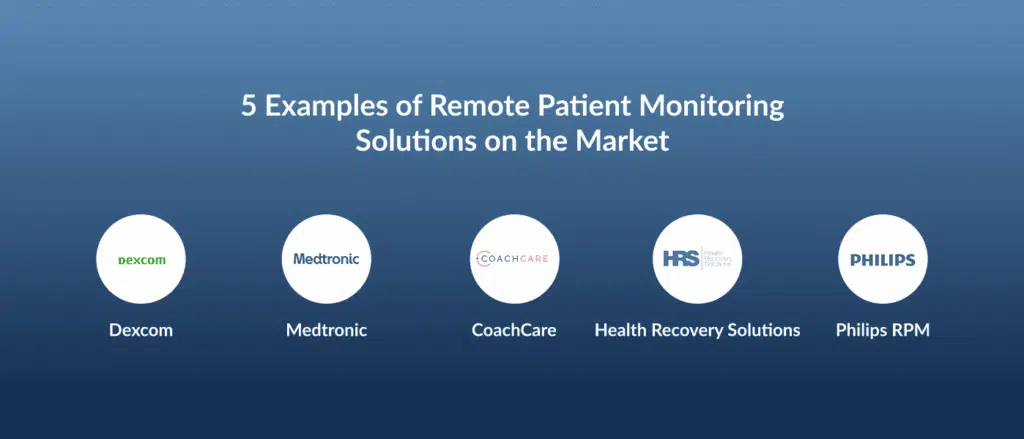
1. Dexcom
Dexcom helps people monitor their blood sugar levels. It uses a small wearable device and an app. Patients can see their glucose levels on their phone. They can also share the data with their doctors and up to 10 family members.
Doctors can use this information to adjust care plans. It’s a great example of combining hardware and software in one patient monitoring software solution.
2. Medtronic
Medtronic offers a full system for monitoring health. Patients wear smart devices that track their vital signs. The data goes to an app on their phone and to their doctor’s dashboard.
Doctors can see this information and take action if something looks wrong. This tool helps doctors act fast and make better health decisions.
3. CoachCare
CoachCare supports clinics with custom remote patient monitoring software. It lets doctors see the patient’s data and make treatment changes.
One great feature is its insurance support. It helps clinics earn more money from insurance while lowering care costs. It also improves treatment results for patients.
4. Health Recovery Solutions (HRS)
HRS focuses on helping people with specific diseases. It uses Bluetooth devices to track health and supports over 80 medical conditions. The platform offers symptom tracking, video calls, and even health education.
Patients can learn more about their health using this app. It also works with EMR systems and supports clinics with training and help.
5. Philips RPM
Philips offers a smart system that sends patient data from connected devices to doctors. Patients can also use a mobile app to add their health details. The software helps doctors create treatment plans and make important health decisions. It uses smart tools to detect serious problems like infections early.
These companies show what a strong remote patient monitoring software can do. With custom patient monitoring software development, you can create an app that fits your business goals and patient needs perfectly.
Work with a trusted healthcare app development company to plan your software development process, choose the right tech, and keep your costs under control. A well-made app can truly improve lives, and bring great value to your healthcare business.
Future Prediction for Remote Patient Monitoring Solutions
The future of remote patient monitoring software looks exciting and full of smart technology.
AI and Predictive Analytics Will Play a Big Role
By 2030, AI (Artificial Intelligence) in healthcare is expected to grow to over $188 billion. What does this mean? It means patient monitoring software will get smarter. AI will help doctors predict health problems before they happen. This allows them to act early and save lives.
Wearables Will Keep Growing
By 2030, there will be over 26 billion wearable devices! These include smartwatches, fitness bands, and health monitors. These tools will help doctors and patients track health in real-time, right from their wrist. This makes care faster, easier, and more accurate.
More Secure and Powerful Software
Modern healthcare software development must follow strict health rules. Trusted software development companies now focus on:
- Keeping patient data private and safe.
- Creating strong and reliable systems.
- Following top health laws like HIPAA and GDPR.
- Making sure the app works well with hospital systems like EHR/EMRs.
- Testing software fully to avoid any bugs or issues.
So, future remote patient monitoring software development will not only be smart, but also safe and dependable.
Conclusion
Remote patient monitoring software is changing the way healthcare works. It helps doctors care for patients without needing them to visit the hospital. With the help of AI and smart devices, RPM apps will become even more powerful in the future.
If you’re planning to develop your own patient monitoring software, now is the best time to start. Choose a trusted software development company that knows the healthcare world. Make sure your app is safe, easy to use, and ready for the future.
FAQs
Q1. How long does it take to build a remote patient monitoring software?
A: It usually takes 4 to 6 months, depending on features, design, and system integration.
Q2. How much does remote patient monitoring software cost?
A: The software development cost may start from $40,000 and go up based on the app’s features and complexity.
Q3. What technology is used in remote patient monitoring?
A: RPM apps use wearables, mobile apps, cloud storage, AI, and IoT devices to track and send patient data.
Q4. How big is the remote patient monitoring market?
A: The RPM market is growing fast. It’s expected to reach hundreds of billions in value by 2030 due to more demand for virtual care.
Q5. What are examples of wearable technology for health monitoring?
A: Smartwatches, fitness trackers, heart monitors, and glucose sensors are popular wearable devices used in RPM.
Q6. How much does it cost to integrate EHR with RPM software?
A: EHR integration may cost around $10,000 to $30,000, depending on the system you want to connect with.

RM Mishra
Co-Founder
Developer Bazaar technologies




